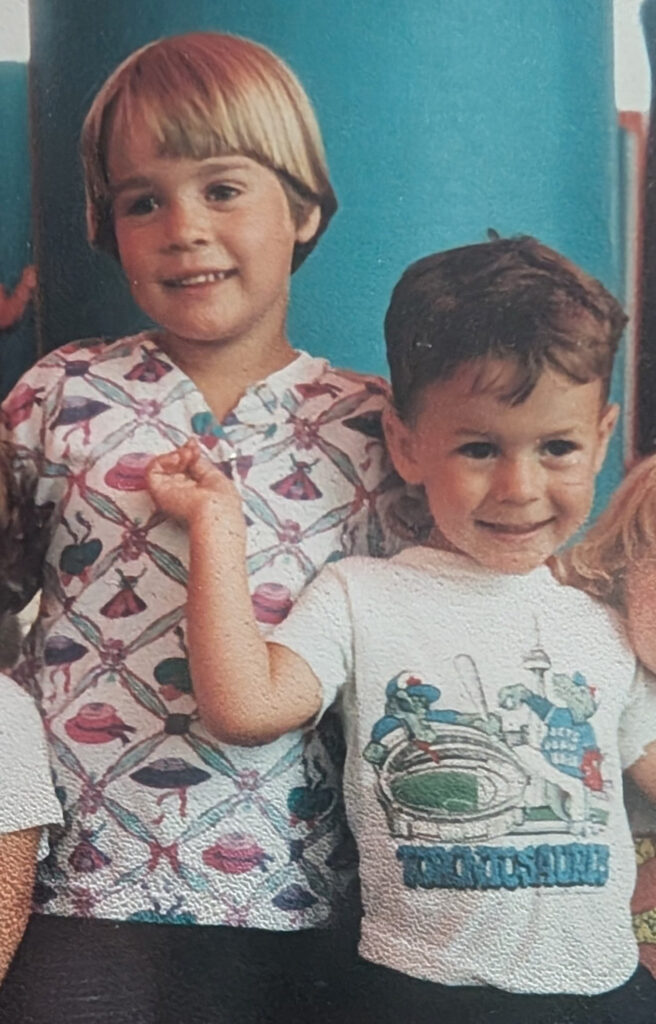From kidney donation to world tour: The transplant journey of two St. Michael’s Hospital patients

SarahJane Smith and Neil Smith at St. Michael's.
Just over two months after donating his kidney to his cousin, Neil Smith tackled a completely different physical feat: He climbed on a stage in Brisbane, Australia and performed in front of 3,000 screaming fans as the front man of a rock band on a world tour.
“Ever since I was a kid, I always dreamed of being a musician having people coming to my concerts super excited to see me play,” says Neil, a member of the Canadian indie rock band, Peach Pit. “My dreams have come true for me. I’ve had a lot of good things happen to me, but none of it really compares to how good it feels to donate a kidney. It doesn’t compare in any way, honestly.”

Back in Toronto, his cousin, SarahJane Smith was experiencing a different kind of euphoria: Freedom from a life on dialysis thanks to her cousin’s donated kidney.
Sign up for the Unity Health Toronto newsletter, a monthly update on the latest news, stories, patient voices and research emailed directly to subscribers. If you haven’t subscribed yet, you can do that by clicking here.
“It’s an invaluable gift that I’ll never be able to repay Neil for,” she says.
At age 27, in the prime of her life, SarahJane went on dialysis after her kidney function rapidly declined. For five years, she had been receiving dialysis – a treatment that removes waste and extra fluid from the blood when the kidneys no longer can – three times a week, overnight at St. Michael’s Hospital. With this schedule, SarahJane lost her ability to travel and make long-term plans. Dialysis is not a cure and it can be challenging. For many, a kidney transplant is a better option.
When it came time for transplant, four of SarahJane’s family members went through testing to see if they were a match. After three unsuccessful matches, the team identified Neil was compatible and able to donate his kidney.
“Because the three of them all got disqualified very late in the game, it was a little disheartening,” SarahJane says. “But it was a lot of tears when Neil passed his tests, that’s for sure. There was a lot of crying. It was a very big day.”

St. Michael’s Kidney Transplant program is a specialized centre for people with end-stage kidney disease. Founded in 1969, the program is one of the largest in Canada. St. Michael’s performs about 150 transplants in a year and follows nearly 2,000 transplant recipients. The team’s ability to tackle the most complex transplant surgeries and provide follow-up care to both donors and recipients gives patients who have often been waiting for a new kidney for years a chance to live free from dialysis.
In the case of living kidney donation, a healthy person’s kidney is surgically removed and transplanted in someone with kidney failure. This is possible because most people can live a normal life with only one functioning kidney. Two teams at St. Michael’s work simultaneously to prepare both the donor and recipient for their surgeries. The surgery for the Smith family was planned for December 2024. Knowing he had to go on tour in February, Neil leaned on his team at St. Michael’s for reassurance about the process and the likelihood he would have a full recovery before he was set to hit the road.
Dr. Michael Ordon, the surgeon at St. Michael’s who performed Neil’s surgery, understands the nerves his patients feel before a surgery like this one. He connected with Neil early on in the process to talk about the typical recovery time and what to expect.
“It’s really nice when you’re in medicine, whether it’s as a nurse, a physician, a physiotherapist, or whatever role it is that you’re in, when what you do on a daily basis can have a positive impact on the patient, and you can see that impact right away,” says Dr. Ordon. “Kidney transplant is one of those things where you get that immediate gratification of seeing the huge positive impact.”
After receiving Neil’s kidney, SarahJane’s life changed. Her energy returned almost instantly. Small tasks she couldn’t imagine doing prior to the surgery – long walks, showers without risk of infecting her dialysis port, and having every evening to herself – are now routine. It wasn’t until after the procedure that she truly realized the constant state of exhaustion her body was in pre-transplant.
Kathryn Salvatore, a living donor coordinator at St. Michael’s, worked closely with Neil during his work-up. To avoid conflicts of interest, donors and recipients work with separate medical teams. At the end of the donation journey, every living kidney donor at St. Michael’s receives a medal after their surgery as recognition for their donation. This is often a meaningful moment for the staff who have been with the donor through every step of their journey.
“They’re always very emotional,” Salvatore says. “You give the medal to the donors, and they are the hero.”
But to Neil, he sees it the other way. He’s grateful he had the opportunity to donate his kidney to his cousin.
“If I think about it, I get a little emotional because it’s definitely the best thing I’ve ever done with my life. It’s been months now and every time it pops into my head, I just instantly just feel so happy.”
Salvatore says it’s important to celebrate each donor and recipient pair.
“I think the Neils and the SarahJanes of the world are unique and special,” Salvatore says. “It’s wonderful to see when it ends this way.”
And now, thanks to Neil, SarahJane has the freedom to plan her future – maybe even her own world tour.
By: Ana Gajic and Caitie Lehman
